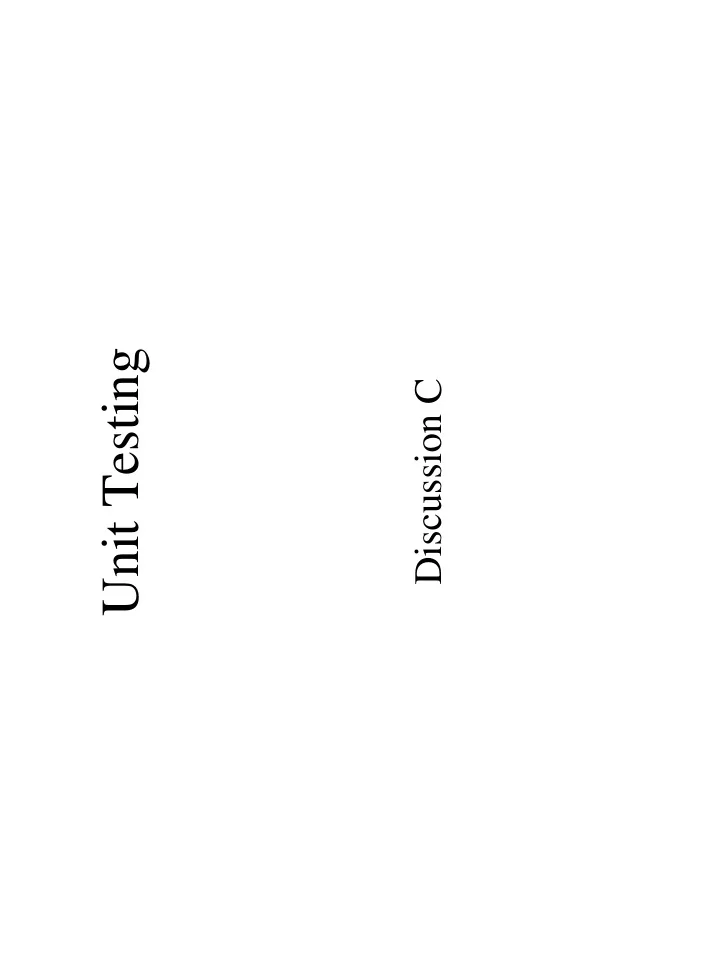

Unit Testing Discussion C
Unit Test ● public Method is smallest unit of code ● Input/output transformation ● Test if the method does what it claims ● Not exactly black box testing
Test ➔ if (actual result != expected result) – throw Exception ➔ Compare different types ➔ String, int, boolean..., Object Expected Computed ? Input method
Functionality ● Computation – Easy to test ● Time based ● Asynchronous interaction – GUI, I/O, Web Application
Power Of 2 public class PowerOf2 { public PowerOf2() {} public int power2(int n) { return 1 << n; } public static void main(String [] args) { PowerOf2 p = new PowerOf2(); for (int i=1; i<=29; i+=2) { System.out.println(i, p.power2(i)); } } }
Test PowerOf2 public class TestPowerOf2 { PowerOf2 pow2; public TestPowerOf2() { pow2 = new PowerOf2(); } public void test() { assert (pow2.power2(5) != 32); assert (pow2.power2(9) != 512); } }
Other tests public String row (int n) { } public int oddPower(int limit) { }
Multiple Tests ● We may have a convention that every TestClass has a test() method ● We can automate by running through a single driver test methods of all the test classes ● Tests that fail throw an exception ● We note which tests passed and which failed ● ... and aggregate results
JUnit test ● JUnit framework provides – setup / assert / teardown sequence ● junit.framework.assert Assert.assertEquals("Message", obtainedResults,expectedResults); ● Group tests with same setup in a test methods ● Group tests into suites
Assert Junit Test class TestPowerOf2 extends TestCase { public TestPowerOf2(String testMethodname) { super(testMethodName); } setUp() { pow2 = new PowerOf2();} tearDown() {} public void method() { assertEquals (pow2.power2(5) != 32); assertEquals(recvd, expect); } public static main(String [] args) { new TestPowerOf2(method).run(); setUp } method } tearDown
TestSuite TestSuite suite = new TestSuite(); suite.addTest(new TestPowerOf2(method1)); suite.addTest(new TestPowerOf2(method2)); suite.run(new TestResult());
TestRunner public class MyTestSuite extends TestCase { public static TestSuit e suite { TestSuit s = new TestSuit(); s.addTest(new TestPowerOf2(method)); return s; } public static void main(String[] args) { junit.textui.TestRunner.run(MyTestSuite.class); } } java -classpath junit.jar junit.swingui.TestRunner MyTestsuite
JUnit Eclipse Integration ● The sooner a bug is caught, the easier it is to fix it ● Continuous testing, ProjectWithJUnit ● Add junit.jar to external jars ● Create new JUnit test (expanding Java) – TestCase, TestSuite ● Run as JUnit
DocumentStatistics ● Different inputs ● JUnit setup/tear down to build test files/streams
DocumentStatistics ● Application Testing ● Invoke main with args ● Compare output with expected results
Prioritizer Software ● You are the software designer ● How do you write tests for it?
Mock Objects ● Time Interface ● Real Time implementation – System.currentTimeMillis() ● Simulated Time – Allows time to be set arbitrarily ● Use simulated time in testing
Recommend
More recommend